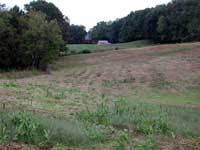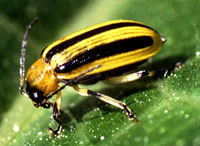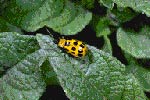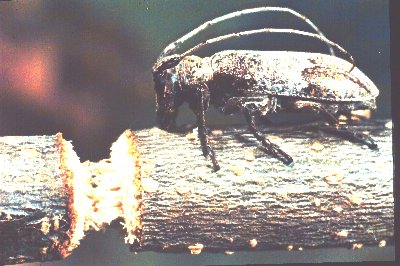

CATTLE GRUB control begins;
TWIG GIRDLERS active on oaks;
HORNWORMS on tobacco


One lucky person who completes a survey will receive a Tubby Smith autographed UK basketball. If you wish to be included in the random drawing to receive the basketball, just enter your e-mail address at the end of the web survey or a telephone number if you are completing a mailed copy. E-mail addresses and telephone numbers provided will be confidential, will be used only to select a winner for the basketball and will be removed from your answers.
If you would like to participate in the Pest Management survey, just go to our web site at http://ces.ca.uky.edu/kyipm/opening.htm or you can request a copy be mailed to you. To request a mailed copy of this survey or if you have questions about this survey or the research you can contact Patty Lucas, P.O. Box 469, Princeton, KY 42445 or telephone at (270) 365-7541 extension 218 or e-mail at plucas@uky.edu.
If you have already completed a survey, thank you.


 Blue mold has been confirmed now in 48 counties in KY, and in CT, OH, NC, PA, TN, and VA. Rain and cooler temperatures that resulted from the passage of a cold front this past weekend (July 22-23) created favorable conditions for the blue mold pathogen. It's likely that a number of new cases of blue mold will be reported in the coming days.
Blue mold has been confirmed now in 48 counties in KY, and in CT, OH, NC, PA, TN, and VA. Rain and cooler temperatures that resulted from the passage of a cold front this past weekend (July 22-23) created favorable conditions for the blue mold pathogen. It's likely that a number of new cases of blue mold will be reported in the coming days.
Growers who are a week or more from topping need to have fungicides in place to protect their crops from blue mold, or from further damage if the disease is present in their fields. Good control of suckers is critical in tobacco that has been topped, as suckers are a prime target for blue mold. Please visit the KY Tobacco Disease Information Page for updates on blue mold and for recommended controls. See http://www.ca.uky.edu/agcollege/plantpathology/ext_files/PPFShtml/ppfsagt8.pdf for list of fungicides labeled for tobacco, or refer to Kentucky Pest News No. 1095. Please contact me if you find or suspect blue mold in your area.
 The EPA approved revisions to the Section 3 label that permit the use of Quadris on burley and dark tobacco. Diseases covered by the revised label are frogeye, target spot, and blue mold. Please note that the revised label supports use rates of 6-12 fl oz/A, as opposed to the 8 fl oz/A rate permitted by the Section 18 that is currently in force. Quadris should be applied prior to the development of disease, or at the first appearance of symptoms. Curative applications are not advised; Syngenta recommends an application of Acrobat + Dithane prior to treating with Quadris IF blue mold is active in the field. Do not make back-to-back applications of Quadris, and do not tank-mix with any product formulated as an EC. Quadris can be applied up to the day of harvest. A maximum of 0.52 lb of active ingredient per acre (31.2 fl oz of product) can be applied per season. The revised label can be viewed at
http://www.cdms.net/ldat/ld5QN036.pdf.
The EPA approved revisions to the Section 3 label that permit the use of Quadris on burley and dark tobacco. Diseases covered by the revised label are frogeye, target spot, and blue mold. Please note that the revised label supports use rates of 6-12 fl oz/A, as opposed to the 8 fl oz/A rate permitted by the Section 18 that is currently in force. Quadris should be applied prior to the development of disease, or at the first appearance of symptoms. Curative applications are not advised; Syngenta recommends an application of Acrobat + Dithane prior to treating with Quadris IF blue mold is active in the field. Do not make back-to-back applications of Quadris, and do not tank-mix with any product formulated as an EC. Quadris can be applied up to the day of harvest. A maximum of 0.52 lb of active ingredient per acre (31.2 fl oz of product) can be applied per season. The revised label can be viewed at
http://www.cdms.net/ldat/ld5QN036.pdf.
For the latest blue mold status and other tobacco disease information, check the KY Blue Mold Warning System online.
![]() http://www.uky.edu/Agriculture/kpn/kyblue/kyblue.htm
http://www.uky.edu/Agriculture/kpn/kyblue/kyblue.htm

For more information about tobacco pests, visit "Insect Management Recommendations".

![]() Last week we received numerous calls and soybean samples from individuals in the Green River Area about soybean plants dying across large areas in some fields with gumbo (clay-loam) soil types. Affected plants were in the early to mid vegetative stages and began dying from the top down about a week after a 5-inch rain. When plants were extracted from the soil, the root systems were observed to be totally dead, white, and rather brittle. In fact, the central portion of the roots (the stele) was all that remained. The few days before and during the time that plants began to die, the weather was extremely hot. Under those conditions, the affected plants apparently were not able to get the water they needed, so they died.
Last week we received numerous calls and soybean samples from individuals in the Green River Area about soybean plants dying across large areas in some fields with gumbo (clay-loam) soil types. Affected plants were in the early to mid vegetative stages and began dying from the top down about a week after a 5-inch rain. When plants were extracted from the soil, the root systems were observed to be totally dead, white, and rather brittle. In fact, the central portion of the roots (the stele) was all that remained. The few days before and during the time that plants began to die, the weather was extremely hot. Under those conditions, the affected plants apparently were not able to get the water they needed, so they died.
The initial concern was that a disease was causing plants to die. Phytophthora root rot (PRR) was implicated by some, but symptoms of dying plants had no consistency with PRR. Similarly, symptoms were inconsistent with Sudden death syndrome, stem canker, charcoal rot, soybean cyst nematode, Fusarium root rot, and any root/stem disease for that matter.
As I indicated above, all the affected fields were of the gumbo soil type. Many of the worst fields had chicken litter applied. As far as the soil type goes, remember that water and nutrient uptake by plants is primarily an active process, and requires soil oxygen to get the job done. Dr Lloyd Murdock (Extension Soil Specialist at Princeton) told me that it takes about two days for a saturated soil to go anaerobic (i.e., insufficient oxygen to support oxygen-requiring [aerobic] processes). At this point, all oxygen requiring systems in the plant's roots are compromised and/or no longer function. If the situation does not change, the lack of root function results in root and, eventually, plant death. By their very nature, gumbo soil types are poorly drained. Apparently the 5-inch rain received by some fields exceeded the field's ability to move out of a saturated state. As a result, plants died where ever soils remained saturated too long.
It is unknown if there is also an exacerbating factor related to the application of chicken litter. According to Dr. Murdock, the breakdown of chicken litter under field conditions is a highly aerobic process. Thus, it is possible that under saturated soil conditions, the additional use of oxygen by microbes breaking down the chicken litter may have resulted in a competition of sorts with plant root systems for available oxygen. This is not normally a problem, even in poorly drained soil types, as long as soils do not remain saturated for an extended period of time. However, when soil is saturated for multiple days, oxygen depletion may take place sooner, and to a greater extent, compared to where chicken litter is not applied. This may be the link with more apparent extensive root/plant death where the chicken litter was applied. Dr. Murdock said it is also possible, but less likely, that plant root death was accelerated in saturated soils with chicken litter applied due to toxicity related to breakdown products of the chicken litter. It was also suggested that the chicken litter may have also helped retain soil moisture, which, in turn, may have helped to maintain saturated soil conditions. Dr. Murdock said this scenario was highly improbable since decomposing chicken litter would tend to assist, not hinder, soil drainage.
For more information about soybean pests, visit
"Insect Management Recommendations".


 Green June beetle grubs are cruising over pastures now and should be particularly abundant where there is a lot of organic matter in the form of accumulated grass clippings or animal manure. Female beetles will chose to lay most of their eggs where organic matter is abundant because this is food for their larvae. In the past, there have been seeding failures as these white grubs churn up the surface soil and uproot emerging seedlings. An application of Sevin may reduce damage from the grubs.
Green June beetle grubs are cruising over pastures now and should be particularly abundant where there is a lot of organic matter in the form of accumulated grass clippings or animal manure. Female beetles will chose to lay most of their eggs where organic matter is abundant because this is food for their larvae. In the past, there have been seeding failures as these white grubs churn up the surface soil and uproot emerging seedlings. An application of Sevin may reduce damage from the grubs.
Green June beetle grubs look like typical white grubs but have a unique behavior that makes them occasional but serious pests in late summer or fall seedings. Most white grubs remain below the soil surface where they feed on plant roots. In contrast, green June beetle grubs frequently travel to and on the surface while feeding on decaying organic matter. The grubs can occur in virtually any field but are most abundant where there is some rotting hay, silage, or animal manure. Fields under an intensive grazing regime or where poultry litter is spread are at higher risk.
Seedlings are uprooted as the grubs backstroke along, plowing the soil surface. They churn the top few inches of soil breaking root- soil contact which kills seedlings, creates dead spots or unacceptably thin stands, and produces bare areas that allow weed emergence. Numbers can be high in established grass or alfalfa fields but the damage potential is not as great.
The green June beetle grub is dirty white with a reddish brown head and legs. They may be found just below the surface in areas where the soil has been disturbed. The grubs typically move on the surface at night but may be forced up by heavy rain or flooding. The presence of 3 to 4 grubs per square foot can disrupt new stands, heavy infestations can have densities of 15 to 20 grubs per square foot. Grubs can move 60 feet or more along the surface in search of higher concentrations of organic matter.
Since green June beetle grubs move to and across the soil surface, they are susceptible to an insecticide application. They tend to die and rot on the surface, which produces a very unsatisfactory situation. In addition, birds feeding poisoned grubs may be poisoned. There is nothing to gain from a treatment at this time.
In Kentucky, green June beetle adults begin to emerge from the soil in late June. The population peaks in the last half of July and most are dead by mid-August. Females lay clusters of about 40 eggs a few inches below the soil surface of soil rich in organic matter. The eggs hatch in about two weeks and the larval stage is present until pupation in late May or early June. The pupal stage occurs in a earthen cell in the soil and lasts 2 to 3 weeks. There is one generation per year.


 When we think of cucumber beetle management, we picture the beetles attacking the young seedlings as soon as they emerge or are transplanted into the field. Preventive control early in the season is important as the beetle vectors bacterial wilt and the disease is devastating to some cucurbits when they become infected early. The beetles can also severely damage or kill young seedlings when their numbers are large. The early damage is caused by the overwintering adult population. In the field now we have the adults of the first generation and the damage they cause is a bit different, they attack the fruit directly. This damage is common with all of the cucurbits, melons, cucumbers, pumpkins, and summer and winter squashes.
When we think of cucumber beetle management, we picture the beetles attacking the young seedlings as soon as they emerge or are transplanted into the field. Preventive control early in the season is important as the beetle vectors bacterial wilt and the disease is devastating to some cucurbits when they become infected early. The beetles can also severely damage or kill young seedlings when their numbers are large. The early damage is caused by the overwintering adult population. In the field now we have the adults of the first generation and the damage they cause is a bit different, they attack the fruit directly. This damage is common with all of the cucurbits, melons, cucumbers, pumpkins, and summer and winter squashes.
While these late-season striped cucumber beetles do feed on the stem and leaf tissues, it is the feeding on the fruit that causes us losses. Feeding sites become callus tissue that affects the appearance of the fruit and loss in marketability. The beetles will attack any part of the fruit, but they are often more concentrated on the underside of the fruit near where it rests on the soil or plastic.
Growers need to monitor for cucumber beetles during the pre-harvest and harvest periods and watch for scarring on the fruit. At this time, squash bug adults and nymphs are active as well. Young squash bug nymphs are sometimes mistaken for aphids as they are green with black legs. But as they increase in size, they become ash colored as their body becomes coated with a fine waxy layer. Larger nymphs can be more difficult to control with insecticides, so growers should try to target younger nymphs with sprays.
Insecticides can be used during this time, but depending on the type of cucurbit and the harvest schedule, growers will need to select an insecticide that has a short enough Pre Harvest Interval (PHI) to fit the schedule. See pages 46, 65, 102, or 125 in ID-36 for a list of the minimum PHI's for approved insecticides on the various cucurbit crops. When spraying for the beetles, its important to keep in mind that the beetles well hidden on the underside of the fruit, so nozzles and pressure should be adjusted to get coverage underneath the dense plant canopy.
During recent weeks, there have been numerous calls made and diseased green bean specimens sent to us from agents and gardeners. The problem most observed has been anthracnose and diseased bean pods in many cases have been so spotted that they were unfit for consumption. Bean anthracnose is caused by the fungus Colletotrichum lindemuthianum; this disease reduces bean quality as well as yield. Losses can be severe following cool, rainy weather. Earlier this season, there were times when Kentucky gardens were exposed to prolonged periods of cool, wet weather. Symptoms. The most striking phase of the disease occurs on the pod. Small purplish-brown spots appear and rapidly enlarge into dark sunken cankers. Often the margin will be a dark brown while the center portion of the canker is light in color. During moist weather, these light centers will contain pinkish spore masses. The disease also affects other above-ground parts of the plant but rarely the roots. Elongate, angular spots appear on the lower leaf veins spreading slightly into surrounding tissue and eventually appearing on the opposite side. Lesions generally are dark brown and may contain pink spore masses during moist weather. Affected seeds are discolored. Plants grown from infected seed will develop cankers on the cotyledons. Bean anthracnose management in the garden.


 Twig girdlers are gray-brown wood boring beetles with a pair of antennae that are about as long as their ¾ inch long bodies. They are active from mid-August into early October when the female lays her eggs. Twig girdlers can be responsible for hanging or fallen twigs on or around a variety of trees including hackberry poplar, linden, redbud, dogwood, and various fruit and nut trees. Heavy infestations can disfigure landscape trees.
Twig girdlers are gray-brown wood boring beetles with a pair of antennae that are about as long as their ¾ inch long bodies. They are active from mid-August into early October when the female lays her eggs. Twig girdlers can be responsible for hanging or fallen twigs on or around a variety of trees including hackberry poplar, linden, redbud, dogwood, and various fruit and nut trees. Heavy infestations can disfigure landscape trees.
The female twig girdler begins the process by chewing a deep V-shaped groove around a small twig and laying an egg in the twig beyond the cut. The girdled portion of the twig that contains the egg will soon fall to the ground. It can be recognized by a smooth cut on the outside of the twig near the bark and a ragged center where the twig breaks. The larva will tunnel into the dead twig and feed until winter. Development will resume in the spring. Ultimately, the larva will pupate in the twig and emerge as an adult late in the summer.
Fallen twigs contain the larvae of this insect so they should be collected and destroyed as soon as practical but before early May of the following year. Hanging twigs should be pruned out and destroyed if practical. An application of Sevin at the first sign of girdling, and repeated twice at two-week intervals, may reduce damage to infested trees. The insecticide kills the adult females before they can lay eggs but will not penetrate the twigs to kill deposited eggs or live larvae.


Application of a cattle grub treatment is one of the Kentucky CPH requirements. Cattle grub damage to muscle and hide requires extra trimming of carcasses and decreases the value of hides. Grubby carcasses are routinely docked by packers. Cattle grub control is a part of producing quality steers for the feedlot. While the damage (cysts or swellings long the back line) will not show up for several months, control measures must be applied to Kentucky cattle between now and October 31 to kill the pests without harming the animal.
Depending upon the species, cattle grub larvae move either to the esophagus (common cattle grub) or spinal column (northern cattle grub)during their migration to the back. The grub larvae are in these sensitive areas during November and December. If large grubs are killed there, the surrounding tissue can become severely inflamed and additional symptoms can develop.
In animals infested with the common cattle grub, the esophagus can swell shut, and produce difficulty swallowing, drooling, or bloat. Northern cattle grubs killed in the region of the spine can put pressure on the spinal column. This results in stiffness in the hind quarters, loss of balance, or inability to lift the hind feet.
Be careful when treating for grubs. Use accurate weight estimates to determine the proper dose. Undertreating may not provide satisfactory control. At best, overtreatment will waste money; at worst, it may cause the animal to become sick.
There are a variety of formulations of cattle grub insecticides. Pour-on or Spot-On products are convenient if good handling facilities are available. High pressure sprays are an alternative when chutes or working pens are not an option. Animals must be wet to the skin when high pressure sprays are used. Products for internal parasite control, such as Cydectin, Dectomax, or Ivomec, also will control cattle grubs. When these products are applied, there is no need to treat with an insecticide, too.
For more information livestock pests, visit "Insect Management Recommendations".


Agronomic samples received in the PDDL this past week included gray leaf spot (Cercospora) on corn; gray leaf spot (Pyricularia) on millet; potassium and magnesium deficiencies, Phytophthora root rot, charcoal rot, downy mildew, Fusarium root and stem rot, and Phyllosticta leaf spot on soybean; black shank, blue mold, tomato spotted wilt virus, Fusarium wilt, soreshin (Rhizoctonia), brown spot, manganese toxicity, and weather fleck (ozone injury) on tobacco.
On fruit and vegetable samples, we diagnosed anthracnose, black rot and Pestalotia leaf blight on grape; Pythium root rot on strawberry; brown rot and scab on peach; Entomosporium leaf spot on pear; Rhizoctonia aerial blight and stem rot, southern blight, and anthracnose on bean; bacterial spot on pepper; Rhizoctonia root and stem rot on southern pea; scab on potato; early blight, Septoria leaf spot, tomato spotted wilt virus and catfacing on tomato; and maize chlorotic dwarf / maize dwarf mosaic viruses (complex) on sweet corn.
Ornamental and turf samples included Pythium and Rhizcotonia root rots on petunia; black root rot on catharanthus; leaf streak on daylily; crown gall on rose; Kabatina twig blight on juniper; scab and fireblight on crabapple; black root rot on holly; Cytospora canker on spruce; Botryosphaeria canker on cherry, dogwood and maple; take-all patch on bentgrass; dollar spot, summer patch and red thread on bluegrass.


UKREC-Princeton, KY, July 14-21, 2006| True Armyworm
| 32
| Corn Earworm
| 25
| European Corn Borer
| 1
| Southwestern Corn Borer
| 107
| Fall Armyworm
| 1
| Black Cutworm
| 0
| | |
View Princeton trap counts for the entire 2006 season at - http://www.uky.edu/Ag/IPMPrinceton/Counts/2006trapsfp.htm
Fulton County trap counts are available at -http://ces.ca.uky.edu/fulton/anr/Insect%20Counts.htm
For information on trap counts in southern Illinois visit the Hines Report at - http://www.ipm.uiuc.edu/pubs/hines_report/comments.html The Hines Report is posted weekly by Ron Hines, Senior Research Specialist, at the University of Illinois Dixon Springs Agricultural Center.
NOTE: Trade names are used to simplify the information presented in this newsletter. No endorsement by the Cooperative Extension Service is intended, nor is criticism implied of similar products that are not named.
Lee Townsend
Extension Entomologist